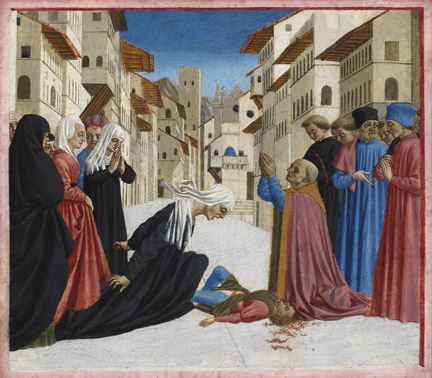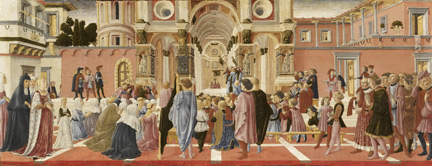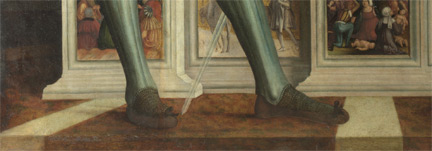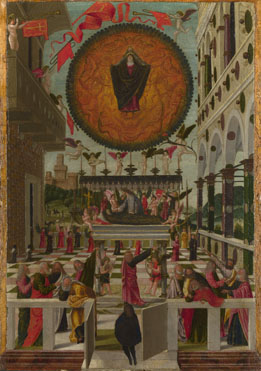Author: Amanda Lillie
2. Painted boundaries, thresholds and inner frames
Immediately inside the frame, artists often created their own painted borders as if they could not risk leaving the important task of delimitation and definition to a carpenter, sculptor, or frame specialist. Yet it was not only a question of establishing exact boundaries for the painted field, and a close look reveals that many artists were developing a more complex notion of the painting’s borders.3
Domenico Veneziano’s Saint Zenobius predella panel incorporates an illusionistic inner frame, painted in dark pink or carmine along the top and the right-hand side to suggest its depth and cast shadow, while paler pink is used to register the fall of light along the bottom of the picture (fig. 4). This creates a window effect for the image, as though we are looking through this frame to the narrative beyond, a technique recommended by Alberti in his treatise ‘De pictura’.4 This painted frame also unifies the panel with the rest of the predella and allocates it to a specific position within the overall framework of the altarpiece by means of its perspectival shadows.5 Even a simple inner frame like this reveals how precisely Domenico Veneziano was planning the work in relation to the viewing process.

The illusionistic pavement edges, steps and sills at the base of paintings provide strong visual evidence that painters were interested in creating the idea of a picture that could be imaginatively entered and occupied. These ledges were probably intended as pointed messages placed low down in the extreme foreground, the area that is most easily approached and closely examined by spectators.
In ‘San Bernardino Preaching’ the edge of the pavement is displayed as though it were a block of paving set up in front of us, with its pavers and white stone dividers shown end on (figs. 5 and 6).6 Whether this was painted by Vecchietta, Francesco di Giorgio, or by another member of their Siena workshop, the artist is likely to have been inspired by a series of predecessors, such as the stepped end of the perspectival pavement in Ambrogio Lorenzetti’s ‘Presentation and Circumcision of Christ’ (1342) from the crossing of Siena Cathedral, or Donatello’s bronze relief of the ‘Feast of Herod’ for Siena Baptistery (1427), where the edge of the diamond squared floor is folded 90 degrees to form a vertical edge for the panel.7


In Costa and Maineri’s altarpiece the same device is employed with the base of its pavement seen so as to display the thickness of the marble (fig. 7). The pavement is no longer flat but has depth. Above all, this emphasises the low viewpoint so that worshippers feel they are looking up at a steeper angle, striving to see the holy figures of the Virgin, Christ Child and saints.8

The pavement edges give out contradictory messages, setting up pictorial illusions while at the same time denying them. These thresholds partly function as doorsteps to invite the viewer in, helping to create the idea of a picture that can be entered. It could hardly be said that they create any sort of barrier, but they do set up a discreet notional separation between the painting and the outer world. Furthermore, they show the thickness and three-dimensional nature of the paving stones as though they were real objects.9 Painters and sculptors showed their architectural sensibilities in their handling of the pavement edge – meditating on the mass and materiality of the pavement. Despite these demonstrations, their edges proclaim the theatrical and fictional nature of the pavement as a delimited stage rather than as continuous space. This is very different and yet complementary to their perspectival construction of deep space. It shows a particular concern for the image as a vertically displayed object, and for perpendicular elevations within the work to balance the other dimensions of horizontality and depth.
In Gerolamo da Vicenza’s ‘Dormition and Assumption of Virgin’ (fig. 8), a succession of entry points is set up by the painter, wittily addressing the spectator on the threshold. This is another case of the artist going beyond the remit of the frame maker. The base of the picture is painted with an illusionistic moulded plinth of dark red marble, establishing the fiction of what we are looking at by declaring itself to be a framed painting. Breaking through this strip of pretend frame, up and over the plinth-like moulding, a white marble step extends out towards the spectator, providing a bridge to enable entry into the sacred zone of the picture. This seems playfully contrary, a form of visual teasing. The artist has first painted a fictive frame to separate the image from our world and then built a fictive bridge across it as though that were necessary to connect us with the world of the image. The next threshold at the front of the picture is an entrance like those to a chancel or a church choir with a marble balustrade and a half-open gate. Above the step is a holier place peopled with saints – symbolically distanced from our world. An alter ego is provided for us, like Alberti’s mediating chorus figure, in the person of a man in black kneeling on the very threshold, strategically positioned half in and half out of the sacred zone.
The set up partly resembles Filippino Lippi’s drawing of Thomas Aquinas [External link] – a study for the fresco in the Carafa Chapel in Santa Maria sopra Minerva, Rome – which includes a set of steps leading purposefully up into the scene. But what is remarkable in Gerolamo da Vicenza's painting is how techniques used to create the theatrical illusionism in large-scale frescoed scenes with nearly life-size figures in churches could be applied to small-scale pictures, presumably for domestic use. The same type of stage setting and visual entry strategies apply.
Read further sections in this essay
- 1. Introduction
- 3. Apertures and arches, porches and loggias
- 4. Open house, open church: architectural dissection
- 5. Interiors: the picture as a room
To cite this essay we suggest using
Amanda Lillie, 'Entering the Picture' published online 2014, in 'Building the Picture: Architecture in Italian Renaissance Painting', The National Gallery, London, http://www.nationalgallery.org.uk/research/research-resources/exhibition-catalogues/building-the-picture/entering-the-picture/painted-boundaries


